Zero, Death and the Horsemen of the Apocalypse
 Despite it's multitude of inventions, China missed one very big one - zero. Like Buddhism, zero arose in India first, probably around the 5th century. China got it by the end of the 8th century, but they don't use it in quite the same way as in western numerals. In Chinese, forty isn't written "4" and "0." Instead, it's written more akin to the Roman way - "4" and "10" (si shi.) What's more, you're considered to be one year old the day you are born. That's right, the very act of going to China adds a year to your age - quite a culture shock for those of us in middle-age denial. Now, I was psychologically preparing to turn forty next year, so it caught me off guard when I turned 40 prematurely, just by crossing China's borders. Four is an unlucky number in China because it's a homophone to the word for "death." Just like you'll have a hard time finding the 13th floor in America, you'll spend a long time waiting for bus number 4 in China. Since the name "Shaolin" means "young forest" and not "middle-aged forest," my sudden promotion to the big "four zero" seemed particularly unlucky, especially for a trip that I was advised not to take.
Despite it's multitude of inventions, China missed one very big one - zero. Like Buddhism, zero arose in India first, probably around the 5th century. China got it by the end of the 8th century, but they don't use it in quite the same way as in western numerals. In Chinese, forty isn't written "4" and "0." Instead, it's written more akin to the Roman way - "4" and "10" (si shi.) What's more, you're considered to be one year old the day you are born. That's right, the very act of going to China adds a year to your age - quite a culture shock for those of us in middle-age denial. Now, I was psychologically preparing to turn forty next year, so it caught me off guard when I turned 40 prematurely, just by crossing China's borders. Four is an unlucky number in China because it's a homophone to the word for "death." Just like you'll have a hard time finding the 13th floor in America, you'll spend a long time waiting for bus number 4 in China. Since the name "Shaolin" means "young forest" and not "middle-aged forest," my sudden promotion to the big "four zero" seemed particularly unlucky, especially for a trip that I was advised not to take.
So here's a koan for you:
why does "fours" rhyme with "wars" but not with "SARS"?
According to Revelations, there will be four horses of the apocalypse: a white horse ridden by a crowned archer, a red horse ridden by a swordsman, a black horse bearing a rider with balances, and a pale horse ridden by Death. There have been many interpretations of what this means, especially lately. Typically, the red horse is interpreted as war, the pale horse, disease and disaster. I left for Shaolin on the thirteenth day of the US attack on Iraq and the news of Severe Acute Respiratory Syndrome (SARS) was breaking. So along with my midlife crisis, my 2003 Shaolin trip came to pass as half of the horsemen of the apocalypse were charging full tilt. These are ill omens for a spiritual pilgrimage, but such desperate times leave little choice. After all, I'm not getting any younger.
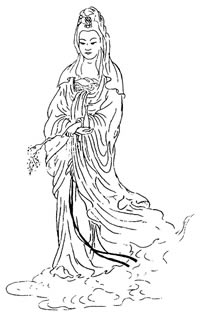 As an impertinent youth, I would have justified my trip in the face of such calamity with that old samurai adage of "throwing my life away." I would have just gone. But as a father, today is NOT a good day to die, not at all. I'm neither samurai nor monk; I'm a family man and a homeowner. If I die "in battle," who's going to put my kid through college? Who's going to make sure that all the monsters are gone from under her bed each night? This was my first Shaolin trip where my daughter was old enough to comprehend my absence. So instead of shaving my head at the temple like usual, I cut it off (with a sword ala Siddhartha) right in front of her to show her it was OK. Since my hair was down to the middle of my back, it was a dramatic change. Afterwards, many people failed to recognize me, but my daughter thought it was the funniest thing ever. I reassured her (and myself) by saying that Kwanyin, the Buddhist goddess of compassion, would protect me. We offered some fresh California poppies from our yard to the little Kwanyin statue in our home. I donned a small jade Kwanyin pendant that I got at Shaolin years ago, kissed my family goodbye, and with a pocketful of face masks boarded a plane to Beijing. Obviously I made it back or I wouldn't be writing this to you now, so perhaps Kwanyin heard our plea. Around the middle of my trip, my daughter told my wife that "Kwanyin came to me in my dream. She took me to Disneyland." Thank you Kwanyin, for looking after my little girl. Submitted for your approval, Shaolin Trips - Episode Two: Reigning in at the Brink of the Precipice, a Shaolin pilgrimage while shadowboxing the apocalypse.
As an impertinent youth, I would have justified my trip in the face of such calamity with that old samurai adage of "throwing my life away." I would have just gone. But as a father, today is NOT a good day to die, not at all. I'm neither samurai nor monk; I'm a family man and a homeowner. If I die "in battle," who's going to put my kid through college? Who's going to make sure that all the monsters are gone from under her bed each night? This was my first Shaolin trip where my daughter was old enough to comprehend my absence. So instead of shaving my head at the temple like usual, I cut it off (with a sword ala Siddhartha) right in front of her to show her it was OK. Since my hair was down to the middle of my back, it was a dramatic change. Afterwards, many people failed to recognize me, but my daughter thought it was the funniest thing ever. I reassured her (and myself) by saying that Kwanyin, the Buddhist goddess of compassion, would protect me. We offered some fresh California poppies from our yard to the little Kwanyin statue in our home. I donned a small jade Kwanyin pendant that I got at Shaolin years ago, kissed my family goodbye, and with a pocketful of face masks boarded a plane to Beijing. Obviously I made it back or I wouldn't be writing this to you now, so perhaps Kwanyin heard our plea. Around the middle of my trip, my daughter told my wife that "Kwanyin came to me in my dream. She took me to Disneyland." Thank you Kwanyin, for looking after my little girl. Submitted for your approval, Shaolin Trips - Episode Two: Reigning in at the Brink of the Precipice, a Shaolin pilgrimage while shadowboxing the apocalypse.
China and SARS
"...behold a pale horse: and his name that sat on him was Death" REV 6:8 KJV
 It was like a ghost flight to Beijing. Each passenger had two empty rows to themselves - comfortable yet very disconcerting. Occasionally, fellow travelers donned their masks as an exercise in irritation tolerance, never long enough to do any good. Of course, it wasn't the flight over I was worried about. Adding to my trepidation were two emails I received just before leaving. The first was from my disciple brother Dr. Rich Russell, mastermind behind www.russbo.com. We were planning to hook up at Shaolin, but he fell ill to SARS-like symptoms in Beijing and fled China just prior to our rendezvous. Rich is a seasoned traveler and a medical doctor, not the type to succumb to travel sickness easily. Was this the sound of one horse hoof clopping? Instead of hearing, "You got mail," it was more like the neighing of that pale horse.
It was like a ghost flight to Beijing. Each passenger had two empty rows to themselves - comfortable yet very disconcerting. Occasionally, fellow travelers donned their masks as an exercise in irritation tolerance, never long enough to do any good. Of course, it wasn't the flight over I was worried about. Adding to my trepidation were two emails I received just before leaving. The first was from my disciple brother Dr. Rich Russell, mastermind behind www.russbo.com. We were planning to hook up at Shaolin, but he fell ill to SARS-like symptoms in Beijing and fled China just prior to our rendezvous. Rich is a seasoned traveler and a medical doctor, not the type to succumb to travel sickness easily. Was this the sound of one horse hoof clopping? Instead of hearing, "You got mail," it was more like the neighing of that pale horse.
The second email was from one of my friends at Shaolin. Phase 3 had begun. This was the final phase of the controversial relocation of Shaolin village away from the Temple that began in the year 2000 (see Karmic Wheel Turns at Shaolin Temple, DEC 2000.) Phase 2 occurred just prior to the last Shaolin festival in 2001 (see The State of Shaolin Temple, JAN/FEB 2002.) Now, after this final phase, Shaolin village was no more than rubble.
 Coming through Beijing airport, masked travelers drifted like hungry ghosts through the ominous landscape of baggage claim. I did get stopped at the security gate, but not for SARS. I had two bottles of single malt scotch in my carry on, gifts for friends from the Duty Free shop in SFO airport. It's now illegal to carry liquor on domestic flights. Having already checked my luggage, I had to scramble back through the terminal to get a small briefcase for checking the bottles in before clearing security. Of course, on the other side of that security gate (and right next to the boarding gate) there was a gift store selling bottles of liquor. Ah, China, only this mighty nation could conceive of such petty bureaucracy. Fortunately, both my health and liquor made it intact. Getting home would be another story.
Coming through Beijing airport, masked travelers drifted like hungry ghosts through the ominous landscape of baggage claim. I did get stopped at the security gate, but not for SARS. I had two bottles of single malt scotch in my carry on, gifts for friends from the Duty Free shop in SFO airport. It's now illegal to carry liquor on domestic flights. Having already checked my luggage, I had to scramble back through the terminal to get a small briefcase for checking the bottles in before clearing security. Of course, on the other side of that security gate (and right next to the boarding gate) there was a gift store selling bottles of liquor. Ah, China, only this mighty nation could conceive of such petty bureaucracy. Fortunately, both my health and liquor made it intact. Getting home would be another story.
Dengfeng and the War
"And there went out another horse that was red: and power was given to him that sat thereon to take peace from the earth..." REV 6:4
 I checked into my Dengfeng hotel under the cover of night, strung out from 19 hours of continuous travel. Despite my lack of sleep, the 16-hour time difference had me up before daybreak. Since it was too dark to go out, I turned on the tube. When traveling alone, television often becomes my constant companion. It made my first China morning into a rude awaking, time for the red horse to gallop in. The news was filled with images of Iraq, but not the patriotic coverage we were getting back in the states. These were images of civilian amputees, of babies in fragments, the cries of children and the other songs of war. It was the sick and awful side of "shock and awe." No matter what your stance is on the war, if you don't see suffering, you aren't seeing the real war. War is hell.
I checked into my Dengfeng hotel under the cover of night, strung out from 19 hours of continuous travel. Despite my lack of sleep, the 16-hour time difference had me up before daybreak. Since it was too dark to go out, I turned on the tube. When traveling alone, television often becomes my constant companion. It made my first China morning into a rude awaking, time for the red horse to gallop in. The news was filled with images of Iraq, but not the patriotic coverage we were getting back in the states. These were images of civilian amputees, of babies in fragments, the cries of children and the other songs of war. It was the sick and awful side of "shock and awe." No matter what your stance is on the war, if you don't see suffering, you aren't seeing the real war. War is hell.
Here in San Francisco, we used to say "Make love, not war." It may surprise you to learn that Buddhists deny love as another delusion. In the Flower Adornment sutra, love is compared to nine things: an unpaid debt, a rakshasa (demon) woman, a wonderful lotus flower whose roots are hiding a poisonous snake, disagreeable food, a prostitute, a mleccha (barbarian), an infected sore, a destructive wind and a comet. However, if love is defined as compassion, compassion is the cornerstone of Buddhism. Passion comes from the Latin passus, meaning "to suffer." In essence, "compassion" means "to suffer with." While our country maintains a right to free speech, our free press chooses to waive that right, focusing almost entirely on the strategy of our attack instead of engaging in substantive debate. Americans did not see the war like the rest of the world. We didn't see the suffering so we couldn't "suffer with." We weren't given the chance to be compassionate. Even with our digital widescreen TVs, no one here saw the big picture, and to this day no one really knows what that big picture might have been.
But soon, the rest of Dengfeng awoke and tore me away from the carnage horror show. Growling unmuffled engines and bleating horns filled the morning commute. It was cold outside, enough to see my breath, and the ground was wet from a midnight drizzle. Standing in the hotel courtyard were three gaudy life-size fake palm trees, the model of modern Asian d?cor. I discovered later that they lit up at night. Since they were my favorite colors - red, green and gold - I decided this was my first auspicious omen. I was in China again. Life was good. I quickly checked my gear, my special Shaolin weight vest of recording devices: cameras (video, digital and conventional film,) tape recorder, batteries, film, tapes and notebook - over 20 lb of gear. I never used that tape recorder; it was just to balance out the weight. As soon as first light came, I hit the streets of Dengfeng.
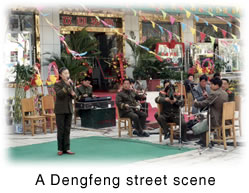 April in Dengfeng was nippy. While the sun peeked through gaps in overcast skies for fleeting moments, it was usually cold and damp. Brisk mountain breezes brought fresh air to the congested city. The mountain weather was hard to predict, sunny one moment, raining the next. It was a bit tough on training, because you don't want to get caught in a chill after practice, nor do you want to lug around a lot of extra clothes when you're exhausted (not to mention recording gear.) Downtown, the constant grind of traffic, pierced by the honks and toots of horns, seemed oblivious to this seasonal fickleness. But it was quiet at night, surprisingly so.
April in Dengfeng was nippy. While the sun peeked through gaps in overcast skies for fleeting moments, it was usually cold and damp. Brisk mountain breezes brought fresh air to the congested city. The mountain weather was hard to predict, sunny one moment, raining the next. It was a bit tough on training, because you don't want to get caught in a chill after practice, nor do you want to lug around a lot of extra clothes when you're exhausted (not to mention recording gear.) Downtown, the constant grind of traffic, pierced by the honks and toots of horns, seemed oblivious to this seasonal fickleness. But it was quiet at night, surprisingly so.
I stayed at the Fengyuan and the Tianrong hotels, both rated 3 stars by the Tourist Bureau. They were both very comfortable, with ample hot water, toiletries, and a TV with a remote - a considerable improvement to some of my previous Shaolin lodgings. I remember once going without running water for a week in '95. That was awful. We were training hard during the blistering dog days of summer. Not only was there no shower, there was no water for toilet flushing. My buddy Rich was ranting at some poor lobby girl, saying that he was going to defecate right there in the lobby if someone didn't bring him some water. Another buddy, Craig McCord (see Ace of Spades, AUG 2000) was getting really irritable. For years, Craig earned his living fighting in Japanese bare knuckle contests. He was not the kind of guy you want to get upset. Things were getting grim. We finally did get water, but by then the whole area reeked of unflushed toilets.
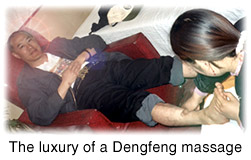 Now that I'm - ahem - forty, I'll take the 3-star lodgings, thank you. A 3-star hotel is pleasantly civilized. Hotel elegance is measured in grandfather clocks, ornate ceilings and polished stone floors. Attendants are constantly cleaning stuff, sweeping, polishing, and dusting - so many attendants. Sitting in the lobby long enough will be rewarded with the attention of a pretty lobby girl, who might bring you a nice cup of tea and an ash tray for your comfort. There's even swimming pools, bowling alleys, even inexpensive massage services for that post-training soreness.
Now that I'm - ahem - forty, I'll take the 3-star lodgings, thank you. A 3-star hotel is pleasantly civilized. Hotel elegance is measured in grandfather clocks, ornate ceilings and polished stone floors. Attendants are constantly cleaning stuff, sweeping, polishing, and dusting - so many attendants. Sitting in the lobby long enough will be rewarded with the attention of a pretty lobby girl, who might bring you a nice cup of tea and an ash tray for your comfort. There's even swimming pools, bowling alleys, even inexpensive massage services for that post-training soreness.
A Dengfeng 3-star hotel TV gets over two dozen stations. Maybe it's the qi of Shaolin, but I usually only sleep a few hours each night when I'm there (which catches up to me eventually.) So whenever I was back in my room, whilst compiling notes, restocking film and fussing with the battery recharger power converters (digital cameras sure eat batteries up,) the TV was constantly on. More than a cathode ray companion, the TV is one of my anthropological duck blinds, allowing me to observe culture in a detached way. Beyond the ubiquitous war coverage, there was almost always some martial arts soap opera program to watch. It's like Kung Fu Theater channel 24/7. I love that. There were plenty of period/fantasy serials like Journey to the West (two different versions were running) and Zhang San Feng. What's more, there were these delightful morning exercise programs that all had this standard format - one leader flanked by two to four others set up like bowling pins, digitally edited on to a surreal computer-generated backdrop. The taiji one was fun, but our company produces taiji videos so I see enough of those. The aerobics, folk dance, and even hip hop dance shows, were far more amusing. My favorite was an aerobic kick boxing type of show that was clearly based on kung fu moves. A few other programs that caught my eye included: an old black and white drama where communism conflicted with Confucianism, ending in extreme personal tragedy (beautiful filmmaking - there's a huge archive of amazingly poignant mainland Chinese propaganda films that have never been released beyond China), a program on how to raise a cat (apparently cats are the rage now - this program advocated keeping kittens in a hamster cage until litter-box trained), a "learn English" show on cooking that explained measuring spoons (measuring spoons are so western - our recipes call for a tablespoon of pepper, no matter how fresh or stale that pepper might be), and a great Bruce Lee documentary.
But despite the niceties, the war haunted my trip like a whinnying banshee, rearing up and kicking whenever I thought I'd left it behind. Whether it was running into a group of Old German ladies who asked me if I had heard any recent news, or the smartass remarks of a shopkeeper asking if I'd like a ticket to Iraq, once anyone discovered that I was American, the topic would turn immediately to war. It's alienating to be outside your own country while it is at war, but you get a better perspective.
Ironically, the Chinese pronounce "Bush" by combining two characters "bu" (clothes) and "shi" (rare.) This is a phonetic translation, so those parenthesized definitions are meaningless. But due to the inflections of Mandarin, Bush sounds a little like "bullshi." All it needed was a final consonant, one that might fit to a "T", and it could have expressed the opinion of much of the rest of the world.
The Dragon's Lair and Kung Fu
"...the dragon gave him his power, and his seat, and great authority." REV 13:2
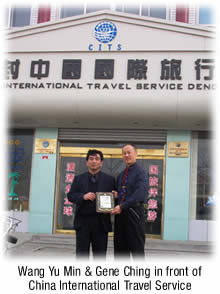 My first interview was with Grandmaster Chen Tongshan, father of Shaolin's child movie star Shi Xiaolong (see The Other Little Dragon, March 2000). Now I did over a dozen interviews, but I'm going to save those for the magazine; so if you want to read that stuff, you'll just have to subscribe. My dear friend Mr. Wang Yu Min of China International Travel Service (see www.dfintertour.com) arranged many extraordinary interviews for our magazine. If you go to Shaolin, drop my name with Mr. Wang, and he'll take good care of you. But back to this story. Although I'm not going to spoil the surprise by revealing those interviews here, I will mention Grandmaster Chen because he kindly arranged for my training during this trip.
My first interview was with Grandmaster Chen Tongshan, father of Shaolin's child movie star Shi Xiaolong (see The Other Little Dragon, March 2000). Now I did over a dozen interviews, but I'm going to save those for the magazine; so if you want to read that stuff, you'll just have to subscribe. My dear friend Mr. Wang Yu Min of China International Travel Service (see www.dfintertour.com) arranged many extraordinary interviews for our magazine. If you go to Shaolin, drop my name with Mr. Wang, and he'll take good care of you. But back to this story. Although I'm not going to spoil the surprise by revealing those interviews here, I will mention Grandmaster Chen because he kindly arranged for my training during this trip.
Chen always comments that we have the same name. My pronunciation of "Ching" comes from my dad's Hakka roots. The Hakka (or Kejia in Mandarin) are kind of like the gypsies of China. There are a lot of us. In fact, this year's Shaolin Festival has yet to be scheduled for two reasons. One is the completion of a new highway to connect Shaolin and Luoyang with the airport and train station hub of Zhengzhou. The other is to coordinate with a massive Kejia conference that is supposed to take place around the same time. Anyway, in Mandarin, "Ching" is pronounced "Chen." Not only do I get a year older in China, my name changes (but at least it doesn't sound like "bullshi.") Herein is just one of the many intricacies of translation from Chinese. Since my Shaolin master, monk Shi Decheng (also a Chen, his family name is Chen Qingzhen) was away in Spain and Italy, this gave me a chance to train elsewhere. I did run into one of my Sifu?s instructors, Xingwei, as well as visit his school a few times (I was pleased to see that I made it in his new school pamphlet.) But since Grandmaster Chen was gracious enough offer me free lessons, I felt it would be a great opportunity to sample something different. He set one of his coaches on me, Coach Zhu Changxing.
Zhu was one of the coaches in charge of Chen Tongshan's demo team. Now most schools in the West can count the times they have performed demos in a year on their two hands. Chen's team demos practically every day. Whether it's for a tour group or a local middle school field trip, they do hundreds of demos annually. And these guys are all hot shots, the top performers in a school of almost 2000 pupils. That's ten times the student body of most strip mall schools here in one school. Here is where many Shaolin critics fail - Shaolin mathematics. Shaolin's numbers are staggering. There are more students enrolled in any one of the large Dengfeng schools than the number of overall attendees at most U.S. national level events. And they all practice for several hours a day, six days out of seven. This environment develops kung fu skill like nowhere else on earth. Just do the math.
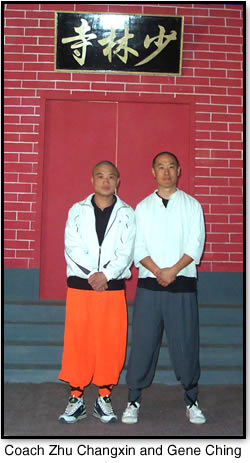 Grandmaster Chen's school is one of the top three schools in the area. His demo team coach, Zhu, commands like a drill sergeant, barking orders with a ferocity that commands immediate respect. He was fast, snapping deep into DI mode quick as a whip, then tempering his criticisms with laughs of camaraderie. It was fascinating to watch him run the team through their paces, giving pointers on how to heighten the drama by exaggerating their qigong stunt foreplay. At present, every private school seems to have their Shaolin Gate demo stage, and they've absorbed a lot from the tours that have gone around the world. Certain acts, like the balancing atop spearheads, appeared parallel to successful tours like Shaolin Wheel of Life. Even the now standard Temple Gate facade is reminiscent of the 1500 Anniversary Tour, and everyone still plays the soundtrack to that tour. Additionally, some new acts like Duck style and broom fighting now break up the shows with a few laughs. However, these shows still are mostly modern Wushu and qigong stunts, since traditional Shaolin kung fu lacks the flamboyance necessary for popular entertainment.
Grandmaster Chen's school is one of the top three schools in the area. His demo team coach, Zhu, commands like a drill sergeant, barking orders with a ferocity that commands immediate respect. He was fast, snapping deep into DI mode quick as a whip, then tempering his criticisms with laughs of camaraderie. It was fascinating to watch him run the team through their paces, giving pointers on how to heighten the drama by exaggerating their qigong stunt foreplay. At present, every private school seems to have their Shaolin Gate demo stage, and they've absorbed a lot from the tours that have gone around the world. Certain acts, like the balancing atop spearheads, appeared parallel to successful tours like Shaolin Wheel of Life. Even the now standard Temple Gate facade is reminiscent of the 1500 Anniversary Tour, and everyone still plays the soundtrack to that tour. Additionally, some new acts like Duck style and broom fighting now break up the shows with a few laughs. However, these shows still are mostly modern Wushu and qigong stunts, since traditional Shaolin kung fu lacks the flamboyance necessary for popular entertainment.
Of course, it was the traditional stuff I was after. Wushu aerials at forty? Forget it. I asked Zhu to teach me Xiao Tongbei, a classic basic form. Within the first ten minutes of our first lesson, my legs began crying from that good old Shaolin burn. Wow, was I out of shape. That comes with turning forty. I remember my first trip to Shaolin. I trained hard for six months in preparation, reviewing all my forms every day, even watching my diet. This time, I barely had time to review my few Songshan Shaolin forms. And my diet? Well, let's just say the eats are really good in Dengfeng and I think I actually gained a few pounds on this trip. On my first trip, all I did was train: two two-hour group lessons on basics and forms, another two hours on sanda sparring, and another private hour or so, every day. Now, it was just one lesson a day, and I was thankful when it was over.
My first lesson was on a Friday, the one day out of seven that Chen students have off. The schools have agreed to alternate their days off, or else the impact of all those students simultaneously out of class would completely overwhelm Dengfeng, and probably escalate the chance of rival street fights. So I found myself alone with Coach Zhu in the enormous dirt training yard of Chen's school. It was strange, like being in the center of a dozen empty football fields. At one point a huge wind came up and covered us both completely with sandy dust. But for the most part it was just me and Zhu, under the shadow of the mountains, training kung fu.
Initially I held back, trying to conserve my energies for all the hiking and research that would fill the rest of my day. But Zhu dialed into my weak points instantly, calling all my bluffs. You learn to be a good judge of skill at Shaolin, and my skill is so comparatively low that I'm an open book there. He knew exactly where to push to force me to dig down. I'm sure it was barely scratching the surface for him. How much can you learn in a week or two of training? But for me, for a brief moment, everything vanished. The interviews, the research, the war, SARS, my home life -- it all left my mind. There was no room for that. There was just a teacher and a student at the foot of a sacred Chinese mountain, Shaolin in its purest form, the transmission of Shaolin dharma, from warm hand to warm hand. It is what I had come for the very first time I went to Shaolin. It is why I will always return. Zhu transmitted the entire form in that first lesson. In our following lessons, he just had me keep doing it, beginning to end, cracking his whip-like coaching commands whenever I tried to slack.
 My last lesson with Zhu took place inside Chen's performance hall with the entire demo team, some 30 or 40 martial artists, watching me on their break. Since I got to watch their demo, I suppose it was a cultural exchange, but they certainly got the short end of the stick. They were very encouraging, and even went so far as to vigorously applaud my miserable attempts at this form that I had just learned. It was really quite embarrassing. I appreciate their etiquette, but the littlest kid there could have whupped my butt, so it felt ridiculous to get applauded for such unspectacular kung fu.
My last lesson with Zhu took place inside Chen's performance hall with the entire demo team, some 30 or 40 martial artists, watching me on their break. Since I got to watch their demo, I suppose it was a cultural exchange, but they certainly got the short end of the stick. They were very encouraging, and even went so far as to vigorously applaud my miserable attempts at this form that I had just learned. It was really quite embarrassing. I appreciate their etiquette, but the littlest kid there could have whupped my butt, so it felt ridiculous to get applauded for such unspectacular kung fu.
Shaolin Valley and the Relocation
"And the merchants of the earth shall weep and mourn over her; for no man buyeth their merchandise any more." REV 18:11
During this trip, I spent less time in Shaolin Valley than ever, since all the action has moved to Dengfeng. But I still wanted to stay at the Wushuguan for a night, just to be there. The night before I left for the Wushuguan, there was a mad wind, screaming and howling, a terrifying outburst of mountain weather. Trees were whipped about and windows and chimneys were rattling, all threatening to snap under the strain. Was a storm coming in? Did the mountain want to block my stay? A distant cloud front formed a foreboding grey wall over the looming peaks. Intermittent power failures robbed me of my 3-star creature comforts, and the one thing I forgot to pack was my flashlight. Things were looking ominous again.
Thankfully, the weather calmed by the next morning, but Shaolin Valley was barely recognizable. Bulldozers were grinding the remaining foundations to rubble as peasants scurried to recycle what they could of the building materials. The entire village was gone, save a few remaining buildings of the mammoth Taguo academy (see The World's Biggest Martial Arts School, DEC 2000.) Taguo couldn't be dismantled in one shot or thousands of students would have been left homeless before the winter chill lifted. As it was, I saw hundreds of students in transit, sleeping in the empty training fields, under the stars, until more Dengfeng housing became available.
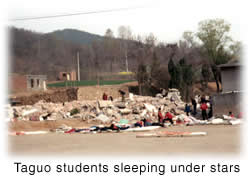 Shaolin village is no more. The unique community that rose up in the wake of Jet Li's 1982 blockbuster film Shaolin Temple was being carted away by the truckload. Gone are the karaoke bars, the exotic meat restaurants, the martial arts supply shops, the monk robe clothing stores, even the rollercoaster simulator. The cheesy tourist traps that made Shaolin valley seem more like Disneyland is now just a memory. In truth, it isn't really gone. It's all moved down to Dengfeng. A new Shaolin village is emerging at the far corner of Dengfeng village closest to Shaolin Valley. Well, not all of it. The rollercoaster simulator didn't make it, but that won't be missed. But as I explored Dengfeng, I found most all of my old merchant friends, still plying me with the same old Shaolin curios at inflated tourist prices.
Shaolin village is no more. The unique community that rose up in the wake of Jet Li's 1982 blockbuster film Shaolin Temple was being carted away by the truckload. Gone are the karaoke bars, the exotic meat restaurants, the martial arts supply shops, the monk robe clothing stores, even the rollercoaster simulator. The cheesy tourist traps that made Shaolin valley seem more like Disneyland is now just a memory. In truth, it isn't really gone. It's all moved down to Dengfeng. A new Shaolin village is emerging at the far corner of Dengfeng village closest to Shaolin Valley. Well, not all of it. The rollercoaster simulator didn't make it, but that won't be missed. But as I explored Dengfeng, I found most all of my old merchant friends, still plying me with the same old Shaolin curios at inflated tourist prices.
In Buddhism, all things as impermanent - war, long hair, Shaolin villages, all things. But originally Buddhism was not designed for lay people - not for homeowners and parents like me. Buddhism was strictly monks who renounced that world. That's why love is compared to infected sores and disagreeable food. Even for monks, it's difficult to adhere to the teachings, so we laypeople retain a lot of attachments. Over the years, I've spent a lot of time in that village and will be the first to confess a deep attachment to it. After all, I like Disneyland. So does my kid. And Kwan Yin too, apparently. For me, those tourist traps made Shaolin all the more real. It was that modern mire of merchandise from which the ancient lotus temple arose. I will miss it.
 But at the same time, once I got past the jackhammers and wrecking balls, Shaolin valley is so much more peaceful now. The hills were bursting with brilliant yellow rape flowers, pregnant with their precious oil to be reaped the next month. White and pink peony petals fluttered in the gentle mountain winds (the Luoyang Peony Festival was coming in the next few days.) Shaolin's natural beauty has emerged again. The valley has returned to an organic calmness, a more befitting setting for one of China's most famous temples. Balancing all things, I'm sad to see the village fade, but I'm happy to see the valley bloom bountiful again. After all the debris is cleared, I'll be eager as ever to return, for I'm sure it will be more beautiful than ever.
But at the same time, once I got past the jackhammers and wrecking balls, Shaolin valley is so much more peaceful now. The hills were bursting with brilliant yellow rape flowers, pregnant with their precious oil to be reaped the next month. White and pink peony petals fluttered in the gentle mountain winds (the Luoyang Peony Festival was coming in the next few days.) Shaolin's natural beauty has emerged again. The valley has returned to an organic calmness, a more befitting setting for one of China's most famous temples. Balancing all things, I'm sad to see the village fade, but I'm happy to see the valley bloom bountiful again. After all the debris is cleared, I'll be eager as ever to return, for I'm sure it will be more beautiful than ever.
Tamo's Cave and Statue
"And I saw another sign in heaven, great and marvelous..." REV 15:1
I spent the day at the Wushuguan running about chasing down more interviews. Things moved quickly, and by late afternoon I had the chance to dash up to Tamo's cave to kowtow and offer incense. I didn't realize how tired I was until that stretch of stone mountain stairs - those of you who've been there know the one - the Shaolin stair-master. Only then did I become aware of all that recording gear I was still bearing. Another tourist (obviously mainland Chinese) coaxed me on with a smiling "jia you!" - that familiar encouragement for anyone who's studied Wushu. It helped me push to the top, but I was soaking wet with sweat and it was cold up there. What's worse, I nearly dropped my videocam as I made my third bow in Tamo's cave. How upsetting. It was as if my duty to the material world, represented by the recording gear, chained me out of reach of this spiritual observance that I treasure most. Here I was in Tamo's cave again, and all this baggage - these attachments - interfered with honoring this sacred place properly. I was ready to chuck all that gear off the mountain precipice, but my boss would have killed me, so I climbed onward, disheartened.
Still shivering from the cold wind and wet clothes, I made it to Tamo's statue on the ridge. Up there, it was so quiet - just me, a Shaolin nun and the chilly wind. I remember when they were building that statue. These little old men carried the stone blocks on their backs up the mountain, one by one, using only their fingers and a thin balancing stick. They could only do it at dawn and dusk because once the sun hit the valley, the stair-master was way too brutal, even unburdened. And here I was complaining now about the weight of my videocam. My old buddy, bare knuckle Craig, once tried to chide me into carrying a stone up with him. "This way we could contribute to this great statue - the Shaolin Tamo Statue!" he said. But once we tried lifting one, there was simply no way I was going to carry one of those rocks. They weighed a ton. Perhaps because I watched it being built, the Tamo statue never had that much of an impact on me. It's beautiful, that's for sure, but it's new, and like many I venerated Shaolin for what was old.
As I kowtowed to that Tamo statue, that perception changed. I experienced a small episode of enlightenment - what Zennists call a Kensho - the trippy part of my Shaolin trips. For an instant, compressed between two heartbeats, everything had its place - family, practice, the village, the statue, the mountain, the apocalypse, the impermanence of everything. Even my videocam and unused recorder fit in the big picture. Such experiences transcend my meager writing abilities now, but I figure if I keep writing around them like this, keep framing them with words, someday I'll be able to translate it to prose. That's part of my personal quest on these Shaolin trips. For now, all I can say is that once again, to my delight, Shaolin showed me just a little sweetness...just a little light. The impact of the experience got me all misty and dreamlike. I must have worked my way back to the cave since the next thing I remember was sitting there - meditating, assimilating and regaining composure.
Once my psyche settled, I realized it was getting dark (remember, no flashlight.) I stumbled back down the mountain as fast as I could, splitting the heel on my shoe on those tortuous stone stairs (fortunately, I did pack my duct tape for just such an emergency.) By the time I got back, Shaolin was closed. No village meant no restaurants, no shop lights and no people. Just darkness. So it was off to bed without supper. That night, the wind howled like the ghosts of mourning gods. My room was probably colder inside than it was outside and the TV only got four channels. I bundled up tightly, struggling to retain my experience at the statue, longing for the heater in a 3-star hotel.
The 1st Shaolin Kung Fu International Symposium
"Repent; or else I will come unto thee quickly, and will fight against them with the sword of my mouth" REV 2:16
Now, you're probably wondering why I even went to Shaolin during this apocalyptic horse stampede. After all, 2003 is a festival year; wouldn't that have been a more appropriate time to go? Instead, I went for another gathering - the 1st Shaolin Kung Fu International Symposium. This was an academic research symposium, the first of its kind. There was an official call for papers from Shaolin Temple in 2002. In fact, we published the announcement, complete with contact information in our September/October 2002 issue. Apparently, the only reader who responded was me.
 One-hundred and thirty-five scholars, professors, monks and masters gathered in Dengfeng for this three-day symposium. Most of the participants were from mainland China, but there was a small contingent of us foreigners, just enough that this could be called an international symposium. Even the Mayor of Dengfeng showed up. I had been trying to track down Mayor Chen Songlin for several days; unfortunately, for a communist party member to be interviewed by foreign press requires specific protocols of which I wasn't aware, so the interview slipped through my fingers. But Mayor Chen, like Grandmaster Chen Tongshan, was pleased to find we were from the same family, so maybe next time.
One-hundred and thirty-five scholars, professors, monks and masters gathered in Dengfeng for this three-day symposium. Most of the participants were from mainland China, but there was a small contingent of us foreigners, just enough that this could be called an international symposium. Even the Mayor of Dengfeng showed up. I had been trying to track down Mayor Chen Songlin for several days; unfortunately, for a communist party member to be interviewed by foreign press requires specific protocols of which I wasn't aware, so the interview slipped through my fingers. But Mayor Chen, like Grandmaster Chen Tongshan, was pleased to find we were from the same family, so maybe next time.
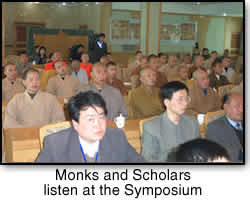 Sixty papers were published in a special edition Chinese book. Topics had to be submitted for acceptance by late August, and then final submissions had to be received by late January. Since our magazine has maintained such a good relationship to Shaolin, I was invited to participate as soon as I submitted my topic. They didn't even want to see my paper, but I finished and submitted it dutifully. My topic was titled The Dragon and the Eagle: The Shaolin Diaspora in America. It was a historical review of popular media coverage, accompanying the general history of Shaolin representatives as they came to America. Actually, I cannibalized an old article, one that I had submitted to our magazine years ago before I took the position here, but never published. Now, this subject has grown too vast to cover meaningfully, so I figured I better put it out now. Of course, I didn't think we'd be at war. The topic of America was a poor choice at this time. My paper was rejected, but I'm posting an annotated version of it here, just for our ezine readers. Such is the prerogative of a publisher.
Sixty papers were published in a special edition Chinese book. Topics had to be submitted for acceptance by late August, and then final submissions had to be received by late January. Since our magazine has maintained such a good relationship to Shaolin, I was invited to participate as soon as I submitted my topic. They didn't even want to see my paper, but I finished and submitted it dutifully. My topic was titled The Dragon and the Eagle: The Shaolin Diaspora in America. It was a historical review of popular media coverage, accompanying the general history of Shaolin representatives as they came to America. Actually, I cannibalized an old article, one that I had submitted to our magazine years ago before I took the position here, but never published. Now, this subject has grown too vast to cover meaningfully, so I figured I better put it out now. Of course, I didn't think we'd be at war. The topic of America was a poor choice at this time. My paper was rejected, but I'm posting an annotated version of it here, just for our ezine readers. Such is the prerogative of a publisher.
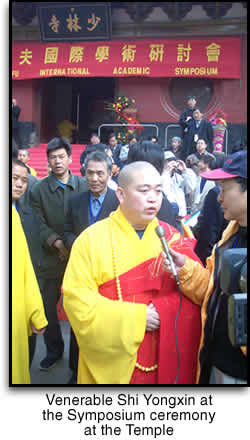 This Shaolin symposium is a sign of things to come. Shaolin Temple was reborn into our time from a kung fu movie, a strange and wonderful reawakening after a rapacious Cultural Revolution. But the childhood of its present incarnation was stained by cinematic caricature. Shaolin became like the Disneyland version of the Brother Grimm, sweet and fluffy, but missing some of the moral underpinning and mythic quality that comprises a 1500+ year old temple. How many remember that Cinderella?s step sisters actually cut off their toes to fit in that glass slipper? You won?t find that scene in the Disney version. Many westerner critics were horrified by Shaolin Disneyland and said that the whole place was no more than a tourist trap museum of fake Wushu monks. Others, like me, defended it. After all, I did the math. While it may not have been the "happiest place on earth," the sheer numbers at Shaolin showed an overwhelming commitment to purpose. If you know to look past the tourist traps, the legacy survives. Now, many of my colleagues who defended Shaolin Disneyland are upset to see it relocated. The critics meanwhile chuckle, saying, "I told you so." But neither side perceives the big picture here. They are all attached to what Shaolin was in the movies and what it was when they went there. They fail to see what it is now, and what it is quickly becoming.
This Shaolin symposium is a sign of things to come. Shaolin Temple was reborn into our time from a kung fu movie, a strange and wonderful reawakening after a rapacious Cultural Revolution. But the childhood of its present incarnation was stained by cinematic caricature. Shaolin became like the Disneyland version of the Brother Grimm, sweet and fluffy, but missing some of the moral underpinning and mythic quality that comprises a 1500+ year old temple. How many remember that Cinderella?s step sisters actually cut off their toes to fit in that glass slipper? You won?t find that scene in the Disney version. Many westerner critics were horrified by Shaolin Disneyland and said that the whole place was no more than a tourist trap museum of fake Wushu monks. Others, like me, defended it. After all, I did the math. While it may not have been the "happiest place on earth," the sheer numbers at Shaolin showed an overwhelming commitment to purpose. If you know to look past the tourist traps, the legacy survives. Now, many of my colleagues who defended Shaolin Disneyland are upset to see it relocated. The critics meanwhile chuckle, saying, "I told you so." But neither side perceives the big picture here. They are all attached to what Shaolin was in the movies and what it was when they went there. They fail to see what it is now, and what it is quickly becoming.
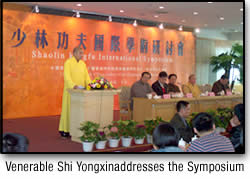 Shaolin is going through some serious growing pains. It is bursting out of the merchant muck and blooming into a new stage of maturity - one that is truly awesome. Get ready. Shaolin is now mightier than ever before, and there's more to come. Like what, you ask? You'll just have to subscribe and find out.
Shaolin is going through some serious growing pains. It is bursting out of the merchant muck and blooming into a new stage of maturity - one that is truly awesome. Get ready. Shaolin is now mightier than ever before, and there's more to come. Like what, you ask? You'll just have to subscribe and find out.
___
Epilogue: Fremont and SARS
"...and he which is filthy, let him be filthy still..." REV 22:11
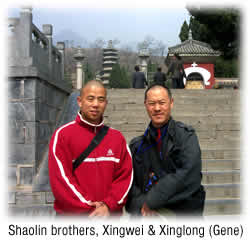 The sweetest moment of my trip wasn't my experience on the mountain. It wasn't the symposium, or my kung fu lessons, or seeing my old Shaolin friends, or the huge mass of research. The sweetest moment was hugging my little girl when I got back to the SFO airport. And yet, even that moment was tainted with the musky aroma of that pale horse. Although I came home healthy, SARS takes up to two weeks to manifest, so I couldn't be positive for half a month. If that person who sat behind me and coughed for the whole flight had SARS, I wouldn't know yet. And I certainly didn't want to bring it home to my family. Four days later, I was sick. Real sick. I had a temperature, extreme body aches and the mother of all sore throats. I called the hospital.
The sweetest moment of my trip wasn't my experience on the mountain. It wasn't the symposium, or my kung fu lessons, or seeing my old Shaolin friends, or the huge mass of research. The sweetest moment was hugging my little girl when I got back to the SFO airport. And yet, even that moment was tainted with the musky aroma of that pale horse. Although I came home healthy, SARS takes up to two weeks to manifest, so I couldn't be positive for half a month. If that person who sat behind me and coughed for the whole flight had SARS, I wouldn't know yet. And I certainly didn't want to bring it home to my family. Four days later, I was sick. Real sick. I had a temperature, extreme body aches and the mother of all sore throats. I called the hospital.
Once they learned I had been in China, they wouldn't even allow me into the building without an approved mask. Of course, the only place to get an approved mask was in the building. It was akin to that problem I had with the carry-on liquor at Beijing airport, only sideways. Thankfully, one of my coworkers got the mask, but as soon as I stepped up to reception, I got yelled at. "You can't be in here! Get out! He's not listening! GET OUT NOW!" This is not what you want to hear when you're really sick, not from the hospital. My Asian eyes and mask combined to such a visage of epidemic horror that I wasn't even permitted into the waiting room. I had to go in through a back door, isolated from everyone else. There, my doctor asked me what I thought they could do for me. There was no test for SARS and no cure. If I did have it, all they could do was quarantine me and support me with IV fluids as my body went to war with the virus. Now I know the paranoia gays must have gone through in the early years of AIDS. Fortunately, I was diagnosed with strep throat, and after ten days of erythromycin I was better.
Our media turned SARS into a carpet to sweep the Iraq war beneath. It's becoming a "yellow fever," a disease that divides us by racial prejudice. Since my trip, people have asked me about SARS in China. Shaolin was fine. China is huge. There is probably more traffic between Beijing and Hong Kong to San Francisco than to Shaolin. So when I went, I only felt vulnerable during my flights. But all things are impermanent. Far be it from me to say where the pale horse rides.
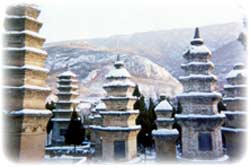 I like to believe that Kwan Yin got me through this time. Compassion can reign in the horses of the apocalypse, but only through the direct experience of suffering and it's accompaniment through the winds of impermanence. I heard that a few weeks after the Symposium, Shaolin's Venerable Abbot Shi Yongxin visited Hong Kong. Upon his return, his group was quarantined for two weeks at the Wushuguan. May Kwan Yin extend her mercy to him, to Shaolin and to the world in these apocalyptic times, the same way she did for me.
I like to believe that Kwan Yin got me through this time. Compassion can reign in the horses of the apocalypse, but only through the direct experience of suffering and it's accompaniment through the winds of impermanence. I heard that a few weeks after the Symposium, Shaolin's Venerable Abbot Shi Yongxin visited Hong Kong. Upon his return, his group was quarantined for two weeks at the Wushuguan. May Kwan Yin extend her mercy to him, to Shaolin and to the world in these apocalyptic times, the same way she did for me.
About
Gene Ching (Xing Long) :
![]() He is Associate Publisher of Kungfu Qigong Magazine, layman disciple name Xinglong
He is Associate Publisher of Kungfu Qigong Magazine, layman disciple name Xinglong
![]() Print Friendly Version of This Article
Print Friendly Version of This Article
















